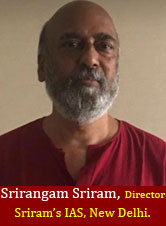To what extent did the activism and political participation of women in Indian National movement promote a feminist consciousness in colonial India? Examine critically. (150 words)
Sakshi Education
By Srirangam Sriram, Sriram's IAS, New Delhi.


From the beginning, women’s participation in politics took place from a variety of women-only organizations, which operated actively in the public arena and focused more directly on women’s political and legal rights. These include Women’s Indian Association, National Council of Women in India and All India Women’s Conference. However, instead of mobilizing mass agitations in support of issues related to women, these organizations petitioned the government and appealed to the nationalists for support.
The developments of the early twentieth century – the birth of a new consciousness, new organizations and the politicization of women – did bring in some remarkable changes for some women. But for most of the women, the changes were less spectacular. In the Swadeshi movement, whatever participation women had, it was within accepted gender ideology that prescribed home as the rightful arena of activities for women.
With the advent of Mahatma Gandhi, a major change in the women’s involvement in the nationalist movement can be seen. Women claimed for themselves a greater active role in the Non-Cooperation movement. Thousands of women participated in the illegal manufacture of salt, picketing foreign cloth and liquor shops and took part in processions during the Civil Disobedience Movement.
In most cases, women who joined the nationalist struggle came from families where men were already involved in Gandhian movements. So in their case, their public role was an extension of their domestic roles as wives, mothers,sisters or daughters. Their politicization therefore did not lead to any significant change in their domestic or family relations.
The female activism during the 1940s was visible most significantly in the Quit India movement of 1942. The most important aspect was the participation of large number of rural women. Outside the country, Indian women were involved by Subhash Chandra Bose in Indian National Army. Women also participated in the communist movements during the period.
Thus, increasingly in the 1940s, Indian women across class, caste and religious barriers claimed agency in their participation in the national movement. But, they did not use the occasion to raise issues that affected them as women as their own goals were subordinated to those of national liberation or class struggle. This nature of participation thus did not abruptly breach the accepted norms of feminine behavior or signify their empowerment.
 Although some women became conscious and actively participated in the political struggles, and also identified themselves in many ways with the emerging nation, feminism had not yet been incorporated into the prevailing ideologies of liberation. But that does not mean that no woman ever dreamed of freedom, in a way contrary to the dominant patriarchal convention.
Although some women became conscious and actively participated in the political struggles, and also identified themselves in many ways with the emerging nation, feminism had not yet been incorporated into the prevailing ideologies of liberation. But that does not mean that no woman ever dreamed of freedom, in a way contrary to the dominant patriarchal convention.
The developments of the early twentieth century – the birth of a new consciousness, new organizations and the politicization of women – did bring in some remarkable changes for some women. But for most of the women, the changes were less spectacular. In the Swadeshi movement, whatever participation women had, it was within accepted gender ideology that prescribed home as the rightful arena of activities for women.
With the advent of Mahatma Gandhi, a major change in the women’s involvement in the nationalist movement can be seen. Women claimed for themselves a greater active role in the Non-Cooperation movement. Thousands of women participated in the illegal manufacture of salt, picketing foreign cloth and liquor shops and took part in processions during the Civil Disobedience Movement.
In most cases, women who joined the nationalist struggle came from families where men were already involved in Gandhian movements. So in their case, their public role was an extension of their domestic roles as wives, mothers,sisters or daughters. Their politicization therefore did not lead to any significant change in their domestic or family relations.
The female activism during the 1940s was visible most significantly in the Quit India movement of 1942. The most important aspect was the participation of large number of rural women. Outside the country, Indian women were involved by Subhash Chandra Bose in Indian National Army. Women also participated in the communist movements during the period.
Thus, increasingly in the 1940s, Indian women across class, caste and religious barriers claimed agency in their participation in the national movement. But, they did not use the occasion to raise issues that affected them as women as their own goals were subordinated to those of national liberation or class struggle. This nature of participation thus did not abruptly breach the accepted norms of feminine behavior or signify their empowerment.
 Although some women became conscious and actively participated in the political struggles, and also identified themselves in many ways with the emerging nation, feminism had not yet been incorporated into the prevailing ideologies of liberation. But that does not mean that no woman ever dreamed of freedom, in a way contrary to the dominant patriarchal convention.
Although some women became conscious and actively participated in the political struggles, and also identified themselves in many ways with the emerging nation, feminism had not yet been incorporated into the prevailing ideologies of liberation. But that does not mean that no woman ever dreamed of freedom, in a way contrary to the dominant patriarchal convention.Published date : 28 Oct 2020 02:22PM













